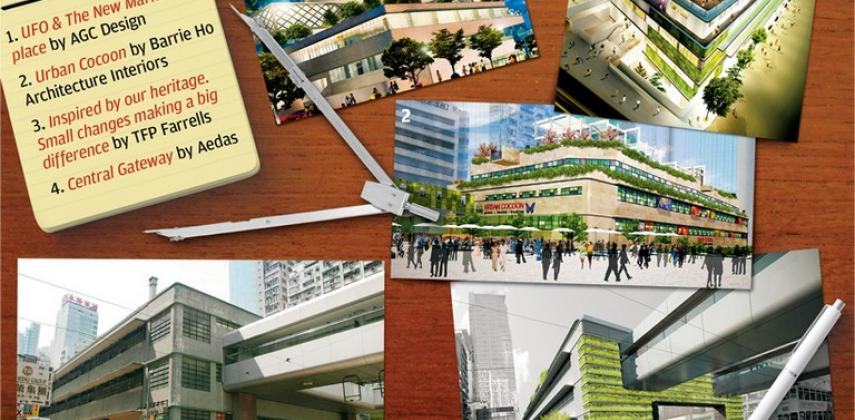Those experienced in building surveying, quantity surveying or estate surveying will be in demand, according to Jeannie Fong Ching-yee, the authority's general manager of human resources and administration. Rehabilitation will become a bigger trend in the next few years, as people pay more attention to building safety, she says. They want to maintain their buildings to avoid major repairs later on.
"We will need surveyors and as we continue to grow, we will also bring in more support staff. When I joined four years ago, there were 250 staff but now we have more than 420," Fong says.
There are about 4,000 buildings that are 50 years old or more in Hong Kong. Over the next decade, 500 a year will be added to the list.
In his policy address last year, Chief Executive Tsang Yam-kuen named rehabilitation and redevelopment as the authority's core business areas in the future. URA will serve as an "implementer" or "facilitator" in future redevelopment projects. It has received rehabilitation applications from more than 800 buildings since last year's policy address, Fong adds.
The government's Urban Renewal Strategy document calls for a comprehensive and holistic approach to rejuvenating older urban areas through redevelopment, rehabilitation, revitalisation and heritage preservation.
Since its board members are appointed by the chief executive, URA is obliged to be accountable and responsive to the needs of the community. It is also expected to work together with stakeholders and participants including government bureaus and departments, relevant district councils, the Hong Kong Housing Society, property owners, developers, individual owners, professionals, and non-governmental organisations.
The authority's work can sometimes be controversial and daunting, as staff find themselves negotiating with owner-occupiers on compensation, land acquisition, site clearance or other deals when not offering technical advice. Therefore, soft skills are important to them, aside from technical knowledge.
"We need people with a housing management or social work background since we have to discuss with stakeholders whether an offer is acceptable and this requires soft skills," Fong says. Rehabilitation does away with the need or urgency for redevelopment, which can trigger controversies over the demolition of familiar neighbourhoods and long-standing social ties in districts. URA offers technical and financial assistance to owners on the proper maintenance of buildings. Its latest Integrated Building Maintenance Assistance Scheme (IBMAS), which came into effect this month, helps owners apply for cash subsidies or interest-free loans. It also offers the flat-for-flat option, an alternative to cash compensation for owner-occupiers affected by the authority's redevelopment projects.
This is the third year URA is conducting recruitment talks at universities to explain the nature of its work to would-be employees. "Urban development is a long-term job," Fong says. "And we need to nurture more local talent. We tell students that besides certain disciplines like urban planning, architecture, and science degrees that are relevant to our work, communication and personal integrity are also important."
URA projects offer more flexibility, unlike the profit-driven projects in the private sector,
she adds. The self-financing authority has seen a growing diversity and volume of urban renewal initiatives including the Central Oasis revitalisation project at the former Central Market which has been laid vacant since 2003. Roving exhibitions are being held on the four submitted designs for the site amid efforts to collect public feedback. URA will issue a tender within two to three months.
On track to expand
The MTR Corporation is on a major recruitment drive as it undertakes fresh projects
The MTR Corporation is set to recruit 900 engineers and other technical staff by 2013 for its new strategic projects.
A spokesman says its projects division will raise its staff number to more than 2,500 from the present 1,600 for the five well-publicised projects comprising West Island Line (WIL), Guangzhou-Shenzhen-Hong Kong Express Rail Link (XRL), Sha Tin to Central Link (SCL), Kwun Tong Line Extension and South Island Line (East).
Recruitment is under way for civil construction engineers in building services, rolling stock and signalling, and for senior inspectors of works for the WIL and Express Rail Link projects.
Begun in July 2009, the construction of WIL will be completed in 2014. The Hong Kong section of the XRL, with its terminus located north of the West Kowloon Cultural District, is expected to be completed in 2015.
That is also the expected year of completion for both the seven-kilometre South Island Line (East) linking Admiralty to the Southern District of Hong Kong, via new stations at Ocean Park, Wong Chuk Hang, Lei Tung and South Horizons, and the Kwun Tong Line Extension, which covers underground stations at Ho Man Tin and Whampoa. Preparation for recruiting candidates for both projects is well under way.
Set up in 1975, the MTR Corporation faces constant demand from transport operators worldwide for professional services and advice in railway planning, design management, system integration and assurance, project management, construction management, railway operations and maintenance, and station business and marketing.
Among its clients are Guangzhou Metro, Shenzhen Metro, Delhi Metro, Taiwan High Speed Rail, Bangkok Metro, Singapore Metro, Singapore Bus Services, Holland High Speed Rail, Dubai Roads and Transport Authority and EDI Rail of Australia.
The company's staff development initiatives include the career management programme and the graduate engineer scheme that provides engineering graduates with all-round exposure in various engineering disciplines.


